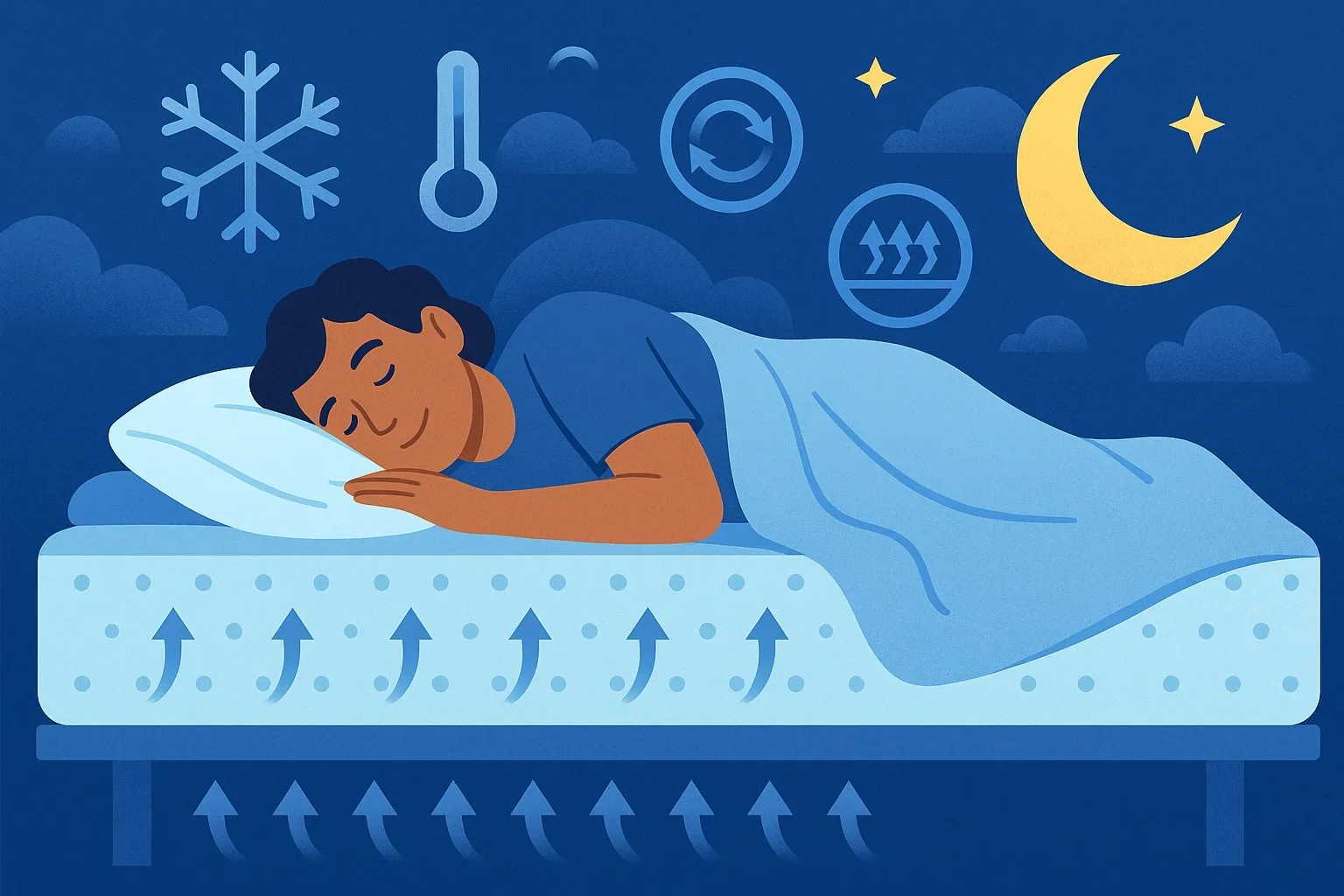Buying Guides
Published June 6, 2025
6 minBuyer’s Guide to Mattress Temperature Control
How to sleep cool all night with the right mattress

Table of contents
Why Hot Sleep Disrupts Your Rest The Science Behind Temperature Control and Sleep Quality How Different Mattress Types Handle Heat and MoistureKey Features to Look for When Shopping for a Mattress Making the Right Investment for Better Sleep
As we dive into the world of sleep health, one issue comes up over and over again: temperature control and regulation. Staying cool throughout the night seems to be at the forefront of everyone’s minds – those of you who suffer from overheating, night sweats, or irregular temperatures are sure to understand why. Sleeping hot is frustrating, uncomfortable, and – most importantly – can significantly impact your overall sleep quality. Luckily, we’re learning more and more about hot sleeping (and how to prevent it).
Why Hot Sleep Disrupts Your Rest
Being a hot sleeper can present some specific challenges, especially when it comes to getting a good night's rest. Night sweats, overheating, and excessive warmth can seriously disrupt your sleep cycles, leaving you tired and irritable the next day.If you’re trying to improve your sleep (and find yourself commonly hot throughout the night), there are quite a few things that you can do. Things like your bedding, mattress, and room temperature can all make an impact on your sleep temperature, with research showing that a cooler sleep environment (around 65-68°F) can help improve both your sleep quality and its duration.The Science Behind Temperature Control and Sleep Quality
But why do we need to sleep cool, anyways? While night sweats certainly aren’t fun, your sleep temperature is actually deeply connected to your sleep physiology. Our core body temperature naturally drops throughout the evening, as a way to signal to our brains that it’s time to go to sleep. This drop is actually a part of your circadian rhythm, which is responsible for your sleep-wake cycle.If you’re too warm while you sleep, this process gets disrupted. You’re more likely to toss, turn, or wake up throughout the night. In fact, hot sleepers are often stuck in lighter sleep stages, missing out on the restorative sleep their bodies really need.How Different Mattress Types Handle Heat and Moisture
Many shoppers don’t realize just how much their mattress can impact their body temperature throughout the night. Different mattress types have distinct properties when it comes to cooling and breathability – so let’s break it down.Memory Foam Mattresses & Cooling
Traditional memory foam mattresses are known for their pressure relief and contouring capabilities, but they’ve also earned quite a reputation for trapping heat. Let’s dive into why:- Dense Cell Structure: Conventional memory foam has a closed-cell structure, which can restrict airflow
- Heat Responsiveness: This is actually one of the benefits of memory foam – it softens in response to heat, creating a sink-in feeling. The con? It can also limit air circulation around your body.
- Limited Breathability: Memory foam is dense and can prevent heat and moisture from escaping.
- Gel-infused foams: Help dissipate heat
- Cooling fibers: Are commonly woven into the surface to make it cooler to the touch
- Phase change materials: Absorb and release heat throughout the night to help your body maintain a consistent temperature
- Open-cell structures: In contrast to traditional closed-cell, greatly improve air circulation
- Plant-based foams: Tend to sleep cooler than traditional petroleum-based ones
Innerspring Mattresses & Cooling
Innerspring mattresses generally provide better temperature regulation than other options, thanks to their open construction.- Coil Systems: Allow for substantial airflow throughout the mattress
- Responsiveness: Innerspring mattresses are less body-hugging, allowing more of your skin to be exposed to air
- Heat Conductivity: With metal coils that actually conduct heat away from the body
Hybrid Mattresses & Cooling
Hybrids, as always, try to find the perfect middle ground between foam and innersprings. This is the same when it comes to their cooling properties.- Airflow Foundation: Thanks to coils that promote air circulation
- Varied Comfort Layers: Often include foams, latex, or other materials with various cooling properties
- Edge-to-Edge Support: Allows you to utilize the entire mattress surface, and avoid overheating in the middle
Latex Mattresses
Natural latex mattresses are often a popular choice for hot sleepers, thanks to their:- Open Cell Structure which is inherently breathable, featuring tiny air chambers
- Responsiveness that doesn’t contour as closely as memory foam, allowing for better airflow around the body
- Moisture Wicking which makes night sweats a thing of the past
Key Features to Look for When Shopping for a Mattress
If you're a hot sleeper shopping for a new mattress, here are some specific features to prioritize:1. Mattress Cover Materials
The mattress cover is your first line of defense against overheating:- Cooling Fabrics: Some mattresses feature specially engineered cooling fibers in their covers
- Phase Change Materials: These high-tech fabrics can absorb, store, and release heat to maintain a consistent temperature
- Tencel Lyocell: Made from wood pulp, this sustainable fabric is exceptionally breathable and moisture-wicking
- Cotton: Natural cotton offers good breathability and moisture absorption
2. Internal Construction
Beyond the surface, consider how the mattress is built:- Pocketed Coils vs. Connected Coils: Individually wrapped coils often provide better airflow than traditional connected spring systems (see our Nectar Hybrids)
- Zoned Support: Some mattresses have different support zones, which can reduce pressure points and the associated heat build-up (like our Nectar Ultra)
- Ventilation Channels: Purposefully designed air channels within the mattress enhance airflow
- Transition Layers: Look for transition layers between support and comfort layers that enhance breathability
3. Additional Mattress Cooling Technologies
Modern mattresses often include specialized cooling technologies:- Copper Infusions: Copper is naturally conductive and can help draw heat away from the body
- Graphite: Similar to copper, graphite helps dissipate heat efficiently
- Cooling Gels: These can absorb and distribute heat throughout the mattress
- Air Cells: Some premium mattresses include air chambers that help regulate temperature











